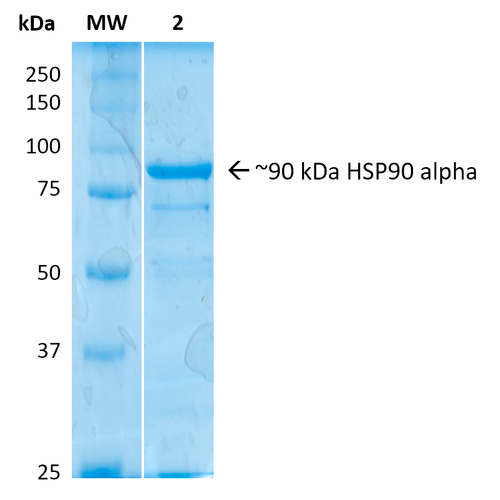SPR-101A SPR-101B SPR-101C
HSP90 alpha Protein
Stressmarq Biosciences
Image

DESCRIPTION
Human Recombinant HSP90 alpha Protein
DETAILS
- Nature: Recombinant
- Purity: >90%
- Target: HSP90 alpha
- Category: Protein
- Conjugate: No tag
- References: 1. Arlander S.J.H., et al. (2003) J Biol Chem. 278: 52572-52577. 2. Pearl H., et al. (2001) Adv Protein Chem. 59:157-186. 3. Neckers L., et al. (2002) Trends Mol Med. 8:S55-S61. 4. Pratt W., Toft D. (2003) Exp Biol Med. 228:111-133. 5. Pratt W., Toft D. (1997) Endocr Rev. 18: 306–360. 6. Pratt W.B. (1998) Proc Soc Exptl Biol Med. 217: 420–434. 7. Whitesell L., et al. (1994) Proc Natl Acad Sci USA. 91: 8324– 8328.
- Applications: WB | SDS-PAGE | ATPase Activity Assay | Surface Plasmon Resonance (SPR) | DARTs Assay (Drug Affinity Responsive Target Stability Assay) | SB (Skin Blotting)
- Field of Use: Not for use in humans. Not for use in diagnostics or therapeutics. For research use only.
- Protein Size: ~90 kDa
- Purification: Affinity Purified
- Concentration: Lot/batch specific. See included datasheet.
- Protein Length: Full Length
- Research Areas: Cancer | Heat Shock | Cell Signaling | Protein Trafficking | Chaperone Proteins | Cancer | Tumor Biomarkers
- Storage Buffer: 50mM Tris/HCl pH7.5, 5mM Bme, 0.3M NaCl, 10% glycerol
- Alternative Names: HSP86 Protein, HSP89A Protein, HSP90A Protein, HSP90AA1 Protein, HSPC1 Protein, HSPCA Protein, HSPCAL3 Protein, HSP90alpha Protein
- Cite This Product: Human Recombinant HSP90 alpha Protein (StressMarq Biosciences, Canada, Cat # SPR-101A)
- Expression System: E. coli
- Species Full Name: Human
- Storage Temperature: -20ºC
- Shipping Temperature: Blue Ice or 4ºC
- Cellular Localization: Cytoplasm | Melanosome
- Scientific Background: HSP90 is a highly conserved and essential stress protein that is expressed in all eukaryotic cells. From a functional perspective, HSP90 participates in the folding, assembly, maturation, and stabilization of specific proteins as an integral component of a chaperone complex (1-4). Despite its label of being a heat-shock protein, HSP90 is one of the most highly expressed proteins in unstressed cells (1–2% of cytosolic protein). It carries out a number of housekeeping functions – including controlling the activity, turnover, and trafficking of a variety of proteins. Most of the HSP90-regulated proteins that have been discovered to date are involved in cell signaling (5-6). The number of proteins now know to interact with HSP90 is about 100. Target proteins include the kinases v-Src, Wee1, and c-Raf, transcriptional regulators such as p53 and steroid receptors, and the polymerases of the hepatitis B virus and telomerase.5. When bound to ATP, HSP90 interacts with co-chaperones Cdc37, p23, and an assortment of immunophilin-like proteins, forming a complex that stabilizes and protects target proteins from proteasomal degradation. In most cases, HSP90-interacting proteins have been shown to co-precipitate with HSP90 when carrying out immunoadsorption studies, and to exist in cytosolic heterocomplexes with it. In a number of cases, variations in HSP90 expression or HSP90 mutation has been shown to degrade signaling function via the protein or to impair a specific function of the protein (such as steroid binding, kinase activity) in vivo. Ansamycin antibiotics, such as geldanamycin and radicicol, inhibit HSP90 function (7). Looking for more information on HSP90? Visit our new HSP90 Scientific Resource Guide at http://www.HSP90.ca.
- Certificate of Analysis: This product has been certified >90% pure using SDSPAGE analysis.
Equivalent Items
| ... Loading